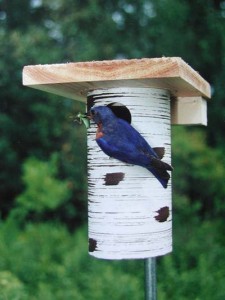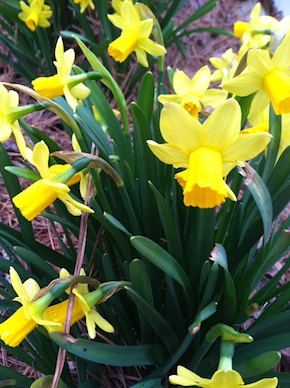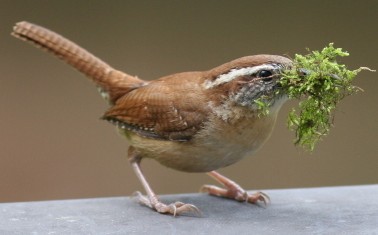-
Vinyl Bluebird Houses that Rock and Secret Sauce for Blues!
 ‘Tis the season, bluebirds are busy claiming territory, finding mates and already nesting in many parts of the country. Because they typically have 2-3 broods per season, it’s not too late to entice them to your place with quality bluebird houses.
‘Tis the season, bluebirds are busy claiming territory, finding mates and already nesting in many parts of the country. Because they typically have 2-3 broods per season, it’s not too late to entice them to your place with quality bluebird houses.Open spaces best suit blues, with places to perch and swoop up insects. They’ll perch on lower limbs of nearby trees, on top of birdhouses, and even on feeder poles. Not only to hunt prey, but to keep a watchful eye over their box and nestlings as well. They’re such tentative parents, with mom & dad’s teamwork accounting for successful fledges!
Vinyl bluebird houses rock because they’ll never deteriorate like wood. The light color is better for late summer scorching temperatures too. This copper roof bluebird house is complete with predator guard and removable roof for easy nest clean-out. It mounts on a standard 4×4 post… no tools required!
The Gilbertson nest Box is also mighty popular among blues. Vinyl with a birch appearance, it’s a great design if you’re up for monitoring nests (recommended). Be polite and always knock first (well, tap) before checking nests!

The secret sauce? In an attempt to bring bluebirds to our yards, and after exhausting all other food treats to lure them, many folks finally resort to offering live mealworms. They do the trick! But what soon happens with many bird addicts (like any addiction) is we’re feeding too many worms and the bird’s diet is skewed.
Extremely high in protein, too many worms can cause problems for female blues during nesting season. Something called egg bound, where she becomes unable to pass/lay her egg. It’s fatal most times, and really sad when seasoned bluebird monitors discover this. It can and does happen in the wild without gorging on meal worms too.
 So if you’ve got the bluebird itch and find yourself feeding lots of worms during nesting season, this supplement helps lower the chance of females becoming egg-bound. Calcium carbonate powder is widely available online, or maybe at your local health and nutrition store.
So if you’ve got the bluebird itch and find yourself feeding lots of worms during nesting season, this supplement helps lower the chance of females becoming egg-bound. Calcium carbonate powder is widely available online, or maybe at your local health and nutrition store.Just a little in the container with a few shakes & swirls to lightly dust worms is perfect. Doesn’t that sound yummy? 🙂 It also helps other females during nesting season should they be partaking (or stealing) your mealies!
-
Life After Death for a Tube Bird Feeder
Maybe it’s seen better life and about ready for the trash, but don’t toss that nasty old thing yet! There could still be purpose for an old tube bird feeder, especially if it’s the kind enclosed by a cage.
With bulbs a- blooming and buds a- popping, spring finally takes flight… at least in the southeast. It won’t be long for the rest of the country either, and oh what a welcome site it is! Cabin fever be gone, it’s gardening time, spring cleaning in the yard, and one of the best times for backyard bird action!
When sprucing up, don’t trash the debris either! Consider a small brush pile in one corner of your property, it not only provides shelter but food for birds and others to forage.
So back to the cage thing, it’s absolutely perfect for offering nesting materials. You can help birds feather their nests with a few common materials that may be on hand. Fido or fluffy? Save the hair, chickadees and titmice will line their nests with the soft fluff. Decorative mosses are really popular with Carolina wrens, jays and chickadees will use them too. Lots of folks use cotton yarn scraps, but if they’re dyed… I dunno? Same with dryer lint, it’s
not natural for birds, so we steer clear. Feathers of any kind (sans the dye) also help in construction of soft fluffy digs. Even birds who don’t use houses will benefit from readily available nest materials!
Don’t have one of those caged things on hand? Suet baskets are also ideal, and something like these spring feeders are perfectly versatile for year-round use. For fruit in summer, whole peanuts or suet in winter, and of course, nesting materials now. Happy Spring y’all!
-
Warblers be Gone- it’s Time for Hummingbird Feeders!
It’s time, farewell and see ya next year! Inundated every winter with pine warblers, it’s good to see them – and good to see them go as their journey North usually coincides with budding trees and blooming bulbs. This event can only mean other migratory birds are on their way, it’s really one of the best and busiest times for backyard birding!
Something about the start of nesting season and the return of hummingbirds that awakens the soul, just plain exciting for those who are really into their backyard beaked buddies 🙂
Because migration maps already show ruby-throated hummingbirds in the gulf states, they’re headed back to their favorite breeding grounds. If you saw the sprites at hummingbird feeders last season, there’s a strong likelihood they’ll return. Are you ready?
If you’re in the southeast, it’s time to dig out feeders and have them in place… this weekend would be ideal! Even if thoroughly cleaned prior to storage… rinse them well before filling. Since natural food sources are still rather scarce, sugar water can be a tad stronger. If using a commercial mix, use a little less water. If making your own nectar (highly recommended) use a 1:3 ratio. 1 cup plain table sugar to 3 cups of water. Migration is the only time nectar should ever be stronger than the standard 1:4 ratio, the extra calories serve tired and hungry birds well.
Consider some nesting material to further entice hummingbirds, after all they did come back to breed. The Hummer Helper Nest Kit was developed specifically for hummingbirds (although goldfinches like it too) and has been endorsed by Hummingbird Society president, Ross Hawkins.
Give tiny sprites a big welcome this year with freshly filled feeders and some nesting materials to help raise their families!
Check out the video and see it in use!








